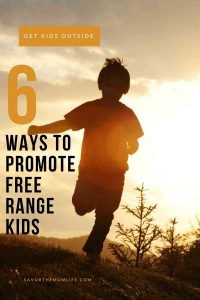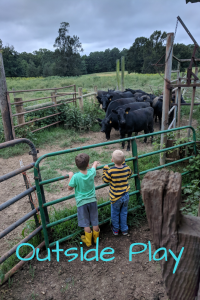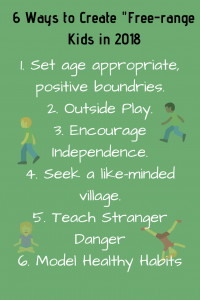
6 Ways to Promote Free-Range Kids in 2018
Or any modern year we are all now living! Let’s promote free-range kids.
Free-Range Kids means giving them the freedoms of earlier generations.
For example, walking down to a friend’s house, to a park, or even just out in the yard to play unaccompanied and on their own. The challenge comes in doing this without going crazy with worry. That worry is caused by social media pressures and many parents peers or other adults not accepting the free-range idea. Read on for 6 ways to promote “free-range” kids in 2018!
It can be possible to have our children living this way but you can’t just kick them out and expect it all to be fine. Just like any stage of parenthood, we have to train them to live and play the free-range way.
I am writing this in hopes to help others and support this concept (or at least a variation of it). I have been struggling with how to give my kids these freedoms while meeting societal norms. Also, my kiddos are only 3 and 5, so we are in the training phase.
I really like the freedoms and development that come with free-range, but in today’s world, it’s not the top parenting choice. I am not into letting my children completely run free in the streets, but rather creating a level of freedom that will encourage them to be independent.
I have been or can be if you click on a link and make a purchase, compensated via a cash payment, gift, or something else of value for writing this post. Regardless, I only recommend products or services I use personally and believe will be good for my readers. Please read my full disclosure for more information.

Here are the Basics for 6 Ways to Promote “Free Range” Kids in 2018:
1. Set Positive, Reasonable, and Age Appropriate Boundaries
2. Encourage Outside Play
3. Seek Out Like-minded Parents for your Village
4. Foster Independence
5. Teach Stranger Danger
6. Model Healthy Habits
All of these 6 Ways to Promote Free-Range Kids in 2018 ideas are intertwined and built on each other. Some of the topics even heavily overlap in my discussion and descriptions. I encourage you to add more ideas about this topic in my comments. I’m always looking for new ideas and points of view.
1. First things first, set positive, reasonable, and age-appropriate boundaries when promoting free-range ideals.
Kids need boundaries. They test them regularly but they are a safety net for children. Boundaries are a part of making them feel and be safe inside and outside of your home. Boundaries should grow with the age and experience of your child. Examples of boundaries inside your home can include screen time, eating only in the kitchen, bedtimes, etc. Examples of outside boundaries can include staying in the yard to play, asking for permission to walk to a neighbor’s house, wearing protective gear when biking, etc.
Any rule you have set can be thought of as a boundary. The main goal is to provide a safe environment, but boundaries should also be used to help foster independence and grow your child into a good human. This is where things like teaching manners can be defined as a boundary as well.
There is such a thing as too many boundaries.
This is where I really like the idea of a more free-range parenting style. They should have just enough to keep them safe but still be able to push limits to do self-learning and discovery. I do like the idea of having my kids in a bubble. We all hate when our children get hurt physically or mentally, but avoiding pain is just not realistic. I want them to learn how to be in this world, and being in a bubble will not support that plan! There are plenty of moments where I cringe, close my eyes, or even walk away because they are trying something with the possibility of being hurt.
Kids are supersizing in their abilities to accomplish things and even to decide on the risk.
I know my son functions far more confidently when I am not around. At Kindergarten orientation, he had to hold my hand the whole time. But on the first day, he walked confidently on the bus and through the halls of his new school.? Another example is this tricycle we have here at our house. One day this summer he took it to the top of our driveway (which is decently steep) and let it drift quickly down. He knew to put his feet down to stop and even to ride to the grass to help him stop. I was nervous but just let it happen. He LOVED it and got loads of energy running back up to ride again.
Letting kids go outside to play on their own, without direct supervision, has been shown to have many benefits for kids.
Concepts like confidence, problem-solving, decision-making, and even empathy, etc. My kiddos are not quite old enough for me to let them outside for long without supervision. Especially my 3-year-old. Her rational capabilities are still in heavy development, but my 5-year-old has more experience. He knows the boundaries I have set when I am outside with them, and MOST of the time he is ready and willing to follow them when I am not around. For example, stay out of the stream, stay in the yard, don’t climb certain trees, etc. We also practice walking to neighbors’ houses and to the bus stop. He is learning the boundaries of how to do that safely with my guidance so that with a little more age he can be free to go on his own.
2. Next is Encouraging Outside Play when promoting free-range ideals.

Nature seems endless, exciting, and full of adventure -, especially for kids. Helping foster an enjoyment of the outdoors totally and completely can push kiddos into the free-range play style. It is better than any video game, inside toys, and sometimes even better than a book!
Exploring the outdoors is still one of my favorite things to do.
Sunlight and fresh air can be some strong medicine. Ways to model and teach your children a love of being outside can include family hikes, camping, gardening together, outside sports, etc.
We all want our children to be healthy. One of the key factors to this is physical fitness.
The outdoors welcomes running, jumping, and movement of all kinds. Playing outside gives freedom and space to do all those things. Another benefit can be learning how to deal with certain discomforts (e.g. heat in summer, cold in winter) and how to dress appropriately. Bugs and allergies are other things all humans have to cope with at some time or another. More outside time means more learning about how to deal with those pests.
My 5-year-old loves figuring things out and asking questions. He is a science lover if I ever met one. Most kids his age fit that description. It’s important to me to put him out in the world to keep that curiosity growing. He asked me the last night if time travel is possible. I told him not right now but maybe one day. And maybe one day it will be him who helps figure it out!
Link about the benefits of playing outside.
Check out my post about Playing and Learning with Nature and Building a Mud Kitchen for Your Kids!
3. Seeking out like-minded parents and other adults for your village when you are promoting the free-range ideals.

When other children are around your kiddos and they have close to the same boundaries and rules as your own children it is magical!
With family, friends, and neighbors around to help guide your children, it can be easier to give into promoting the free-range freedoms for kids.
Things, like walking down to a neighbor’s house, sleeping over at a friend’s home, playing outside, or even walking to a park unattended, are all things that will be easier with other supportive adults around. I’m talking specifically of peer parents we can in-trust our children to and neighbors and family who are trusting of how you are training your children to be respectful and aware of the world around them. This also means your kiddo’s friends will be like-minded as well.
We, humans, need others around us to make life so much more fulfilling.
Obviously, we want to be kind to all and impart that to our children. However, teaching them how to choose those people whom we become close to can help guide their later life experiences when we are giving in to those freedoms we want them to have.
As a parent of a teen, I would imagine it would be easier to trust them on outings if you are comfortable with their friends with whom they will be going. Sow the seeds early on how to choose to be around people who will be good for you!
I know I love when I have friends with whom I feel comfortable setting boundaries for their children as well as them setting them for my own. Teamwork! It takes a village.
4. Fostering independence in your children when promoting free-range ideals.

This starts by having them ask for what they want as they begin talking, and moves to them going for what they want with their actions – on their own.
I have already touched on this topic in the other categories, but it’s so important that it needs to be mentioned in a stand-alone category. Independence and confidence come from setting those boundaries and they are all key to promoting “Free-Range” Kids.
As a parent, if you know your children are independent and confident enough to take care of themselves while following the necessary boundaries, it is much easier to give them more freedom.?
I know I find it hard to be patient in many of the learning stages – potty training, tying shoes, buckling themselves in the car, cutting their own food, etc. These are all steps to becoming independent. Slowing down and giving our children the time and support to try these things on their own will give them, and us parents, confidence!
My story earlier about my son riding down the driveway on the trike was under the “outside play” category, but it also fits here. He independently came up with the idea of where to ride the trike. I feel like it gives him more confidence to be creative with his outside play. He can find ways inside his boundaries to play on his own when given the chance.
Check out more on Independent Play Here:
3 Magic Ingredients for Successful Independent Playtime
How to Rotate and Organize Toys to Promote Intentional Play
8 Ways to Get your Toddler Helping with Chores
5. Teaching Stranger Danger when promoting free-range ideals.

It’s wonderful to teach kids how to be friendly, caring, and respectful. If we are sending them out on their own, it is also good to address the idea that there are some people out there who do not fit this mold.
As a parent, it is not our favorite topic but one that is forefront of our brains very regularly. We have to be ready to talk with our kids about the uncomfortable situations that could arise so they will be more ready to confront them.
I don’t know about you, but placing my trust in others with my children is a big deal.
All too often, we hear stories of abuse at the hands of people we trust. The world is a scary place. Here is where seeking a like-minded village is linked to teaching stranger danger. Kids have to learn their own boundaries and have the skills to recognize and react when someone else crosses them.
Stranger Danger points of discussion when Promoting Free-Range Kids
1. Giving children strategies for what to do if they need an adult and you, the parents, are not around. Who is the right kind of person to approach for help?
2. Teaching them how to respectfully and safely get out of an uncomfortable situation that does not coincide with their boundaries. If they find themselves in a situation with a person or place that is not safe, how can they get out?
3. Seeking out friends that fit. Who do they enjoy spending most of their time with? Who has similar boundaries to their own?
4. Learning to notice when a situation could be unsafe or boundary-crossing. Are they aware of the environment around them (people and places)?
Stranger Danger for Children-4 Ideas to Explain and Prepare.
These are all concepts that touch on the darker side of letting our children out into the free-range world. I will be writing another article soon detailing these 4 ideas and examples of how to teach them.
6. Lastly is modeling healthy habits when promoting free-range ideas.

For children to follow the boundaries, grow in confidence, and become independent, they need their parents to show them the way. Model how to speak respectfully to others, take care of personal hygiene, eat well, enjoy the outdoors and physical activities, and show how to make and take care of friends and family.
Showing our kids how we master these skills and teaching them how to accomplish them is the biggest way we can boost our confidence as well as theirs to be out in the world. To be free-range!
6 Ways to Create “Free-Range” Kids in 2018

Here are some books about this topic if you are looking for more reading! Please follow my awesome affiliate links.?
I hope you enjoyed reading 6 Ways to Promote Free-Range Kids in 2018. If you like this please check out another post about 8 Fun Ways to beat cabin fever with the Kids.
You May Also Like

Parents Feeling Guilty About Screen Time?
January 18, 2019
The #1 Hopeful Wish Parents have for their Children
June 22, 2018




3 Comments
Alexandra
Some fantastic tips right here! I don’t have children, but I will be sharing with friends of mine who do. Thank you 🙂
Kristena
First and foremost, I freaking love the title (free range kids), it makes me laugh! I can definitely relate to some of the stories you have mentioned here. I am a mother of 4 children and some severe anxiety about what other parents think, or society, on how I parent my children. However, I am trying to kill that anxiety because after already raising one child to adulthood and seeing how hard she struggles and has no idea how to do things on her own I have realized that me worrying about what others think of how I parent my children has been a detriment to her in so many ways. Only you know your children and what you would like them to become when they are adults. You have to remind yourself that you are not going to live forever and these children are going to have to know how to survive without you one day. So teaching your children to be independent while keeping them safe at the same (especially in today’s world) is a must. You can’t do everything for them and keep them from experiencing things on their own because they need to learn how to fix things themselves for when you are no longer there. I think more parents should take a look at your article because they are some great tips on how to go about doing this.
Savorthemomlife
Thank you very much! It is really hard to let go for so many reasons! But at a certain point it’s important to help them spread their wings! I am glad you liked my tips.